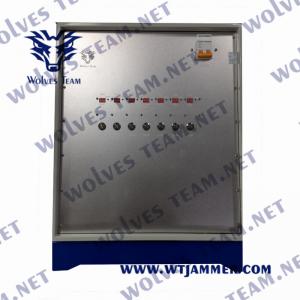DRFM Take IED Bomb Jammer RADAR System 6-18GHz Aluminum Housing
Add to Cart
Radar Ku Band Detection Tracking Distance up to 2500 Meters Tracking airplane and boat
Product Description:
WT-R6000 Radar Detection three-dimensional ground/low altitude
radar surveillance system is a set of three-dimensional space
surveillance radar for low altitude small targets,
omni-directional, high elevation coverage. It is mainly responsible
for real-time reconnaissance of birds, aircraft, ground personnel,
vehicles and other targets in the surrounding area, discovering and
tracking targets, and outputting or reporting target information to
designated users. Radar supports three kinds of erection modes:
fixed mode, vehicle mode and portable mode. It is flexible for
different application scenarios.
Product characteristics:
1) All-Space Three-coordinate Detection
All-day, all-weather and large-scale regional reconnaissance and
surveillance can effectively acquire the azimuth, distance and
altitude (pitch angle) three-dimensional position information of
surrounding aircraft and birds, which has the characteristics of
long detection distance and high data rate.
2) Target tracking and guidance
The radar can not only realize the search and detection of the
surrounding targets, but also report the information of the
detected targets. It can also guide high-precision angular
measurement equipment according to the user's choice of high-speed
tracking target. 64 targets can be tracked at the same time, and
the position coordinates of the targets can be updated regularly.
3) Strong recognition ability
Radar uses automatic target classification and recognition. It can
detect and recognize small targets at low altitude (personnel,
vehicles, small UAV, helicopters, birds), and the recognition
probability is more than 80%.
4) Strong adaptability
It can meet the needs of target detection in plateau, mountain,
hilly and other complex environments. At the same time, the target
information can be real-time output to the operator, or through
communication equipment, reported to other equipment to complete
the target information guidance.
1. Working band: Ku band
2. Detection and tracking distance: 2.5 km (Xinjiang Elves 4);
3. Radar antenna detection range: horizontal direction (+45) pitch
direction (+8);
4. The rotational range of Yuntai-borne radar is 360 pitch
direction - 50 +60 in horizontal direction.
5. Distance accuracy: <5m;
6. Speed accuracy: <0.5m/s;
7. Angular measurement accuracy: <1 degree;
8. Minimum detectable target velocity: <0.24m/s;
9. Multiobjective Tracking Upper Limit: 32
10. Protection Level: IP65
RADAR pulses are often very high frequency, so it’s important to have an extremely fast sampling and processing abilities. All RFDM modules have fast ADCs with high dynamic range which feed directly into a large, fast FPGA like a Virtex-5 [2]. To actually receive and retransmit the RADAR signal, an RF frontend is necessary. A typical RF frontend will contain an antenna, filter or filter bank, amplifier, and if the design is superheterodyne, a mixer and LO [8]. DRFM for more advanced RADARs that use techniques like pulse compression involves detecting any additional modulation imparted to the incident waveform and accurately recreating it using Direct Digital Synthesis (DDS) in real time [9]. Handling advanced RADAR signals like pulse compression is active area of research, almost all of which is classified.



